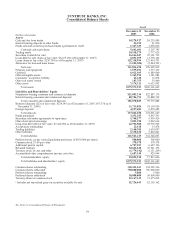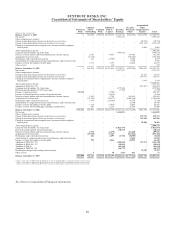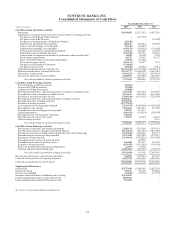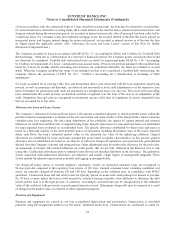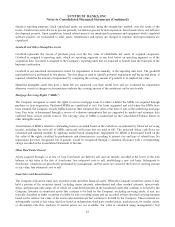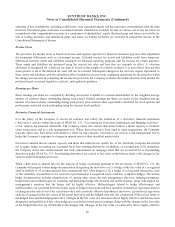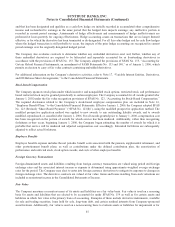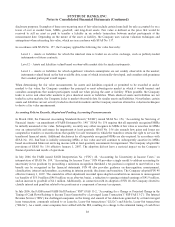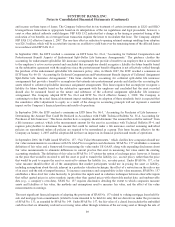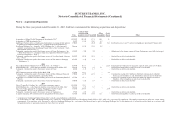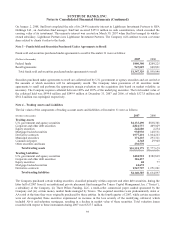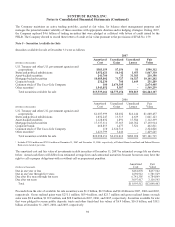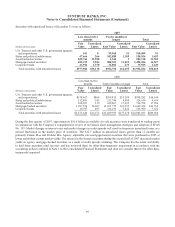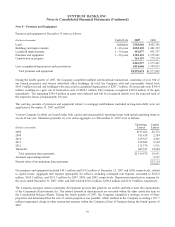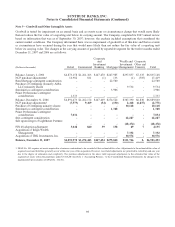SunTrust 2007 Annual Report Download - page 100
Download and view the complete annual report
Please find page 100 of the 2007 SunTrust annual report below. You can navigate through the pages in the report by either clicking on the pages listed below, or by using the keyword search tool below to find specific information within the annual report.SUNTRUST BANKS, INC.
Notes to Consolidated Financial Statements (Continued)
disclosure purposes. Examples of these non-recurring uses of fair value include certain loans held for sale accounted for on a
lower of cost or market basis, MSRs, goodwill, and long-lived assets. Fair value is defined as the price that would be
received to sell an asset or paid to transfer a liability in an orderly transaction between market participants at the
measurement date. Depending on the nature of the asset or liability, the Company uses various valuation techniques and
assumptions when estimating fair value, which are in accordance with SFAS No. 157.
In accordance with SFAS No. 157, the Company applied the following fair value hierarchy:
Level 1 – Assets or liabilities for which the identical item is traded on an active exchange, such as publicly-traded
instruments or futures contracts.
Level 2 – Assets and liabilities valued based on observable market data for similar instruments.
Level 3 – Assets or liabilities for which significant valuation assumptions are not readily observable in the market;
instruments valued based on the best available data, some of which is internally-developed, and considers risk premiums
that a market participant would require.
When determining the fair value measurements for assets and liabilities required or permitted to be recorded at and/or
marked to fair value, the Company considers the principal or most advantageous market in which it would transact and
considers assumptions that market participants would use when pricing the asset or liability. When possible, the Company
looks to active and observable markets to price identical assets or liabilities. When identical assets and liabilities are not
traded in active markets, the Company looks to market observable data for similar assets and liabilities. Nevertheless, certain
assets and liabilities are not actively traded in observable markets and the Company must use alternative valuation techniques
to derive a fair value measurement.
Accounting Policies Recently Adopted and Pending Accounting Pronouncements
In March 2006, the Financial Accounting Standards Board (“FASB”) issued SFAS No. 156, “Accounting for Servicing of
Financial Assets – an amendment of FASB Statement No. 140.” SFAS No. 156 requires that all separately recognized MSRs
be initially measured at fair value. Subsequently, an entity may either recognize its MSRs at fair value or amortize its MSRs
over an estimated life and assess for impairment at least quarterly. SFAS No. 156 also amends how gains and losses are
computed in transfers or securitizations that qualify for sale treatment in which the transferor retains the right to service the
transferred financial assets. Additional disclosures for all separately recognized MSRs are also required. In accordance with
SFAS No. 156, SunTrust is initially measuring MSRs at fair value and will continue to subsequently amortize its MSRs
based on estimated future net servicing income with at least quarterly assessments for impairment. The Company adopted the
provisions of SFAS No. 156 effective January 1, 2007. The adoption did not have a material impact on the Company’s
financial position and results of operations.
In July 2006, the FASB issued FASB Interpretation No. (“FIN”) 48, “Accounting for Uncertainty in Income Taxes,” an
interpretation of SFAS No. 109, “Accounting for Income Taxes.” FIN 48 provides a single model to address accounting for
uncertainty in tax positions by prescribing a minimum recognition threshold a tax position is required to meet before a tax
benefit can be recognized in the financial statements. FIN 48 also provides guidance on derecognition, measurement,
classification, interest and penalties, accounting in interim periods, disclosure and transition. The Company adopted FIN 48
effective January 1, 2007. The cumulative effect adjustment recorded upon adoption resulted in an increase to unrecognized
tax benefits of $55.0 million ($46.0 million on an after-tax basis), a reduction to opening retained earnings of $41.9 million,
and an increase to goodwill of $4.1 million. Additionally, in connection with its adoption of FIN 48, the Company elected to
classify interest and penalties related to tax positions as a component of income tax expense.
In July 2006, the FASB issued FASB Staff Position (“FSP”) FAS 13-2, “Accounting for a Change or Projected Change in the
Timing of Cash Flows Relating to Income Taxes Generated by a Leveraged Lease Transaction”(“FSP FAS 13-2”). The Internal
Revenue Service (“IRS”) has challenged companies on the timing and amount of tax deductions generated by certain leveraged
lease transactions, commonly referred to as Lease-In, Lease-Out transactions (“LILOs”) and Sale-In, Lease-Out transactions
(“SILOs”). As a result, some companies have settled with the IRS, resulting in a change to the estimated timing of cash flows
88



